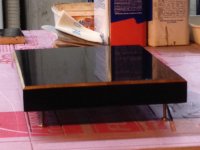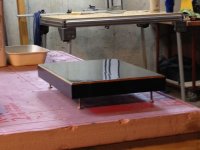I don't know if I would want a mirror finish on plain sawn oak. The medullary rays will cause a refraction of the light being returned from the surface. That alone will affect the reflective properties of the surface.
The 2000 series Target finishes are water bourne alkyd varnish. They are not lacquers. The 6000 and 7000 series Target finishes are water bourne lacquers. Varnish does not polish well.
I don't have an Earlex HVLP, so some of the numbers apply to my Q4. I change needles, orifices as need be. I also mix air caps to fit my needs.
I suggest prepping a test piece(s) with the exact same finish schedule as your table will have. Place them next to each other during the finish process, what you do to the table you do to your test piece(s).
With the above in mind (I would);
Squeegee on a water based wood filler for oak floors, sand when dry, repeat until rays are level and all pores are filled.
Brush treat all end grain with a 10% cut finish or 1000 series (best choice) sanding sealer (I would use Zinsser Seal Coat, but it is alcohol based, you need a safe place to spray it.) . May take 3 or 4 coats. On a table this size it is easier to brush than spray the edges.
Spray on the entire table 2 or 3 coats of 10% cut or 1000 series sanding sealer. If your sprayer came with a Ford 4 cup, 20-22 seconds. Allow to dry a few hours, sand the final coat with 400 grit.
Target does not make a retarder for their 2000 series products. I would test spray some with a 10% add of Floetrol. The finish should be at 28-30 seconds on the Ford 4. You can do this will your waiting for the sealer to cure. Spray on a vertical surface, no sags, good grip and no orange peel your good to go. Remember to spray with your shoulder, not your wrist. You MUST keep the gun parallel to the surface at all times. Any change in film thickness shows in the finish.
Assuming you are using gloss finish. You should not have to polish the varnish.
If you really want to try to polish, here are the steps I use for lacquer;
All of the above (with change in coats noted in the next line).
Spray 4 coats of finish sanding with the grain at number 2 and 4. Tack between each sanding with a damp micro fiber cloth. Spray on coat 5.
Let cure a few days.
You are using an RO sander, while the piece is curing, order Griots polish (order their sealer also) and wait for delivery. Their polish is designed for RO polishers. I believe the Festool polish is designed for the Shinex, a rotary polisher. There is a big difference in the way the polish breaks down.
If you have no orange peel try just polishing the surface. If all is good, seal and wax. Do not use a cleaner wax. It will scratch the surface.
If there is orange peel, I would make a judgement call on which grit to start with. I'll have you start with 800. Do not sand with just your hand on the paper, it is not flat. You must us a block or special sanding sponge. I'd also suggest if this is your first attempt, wet sand. It is more forgiving than dry sanding. Move on to 1200, 1800, finish with 2400. Make sure you clean very well between each grit change, any remnants of the previous grit will mess up the surface. (I have cloths to 12000)
This being your first attempt, use the medium sponge to start. Just safer than the felt for someone just starting.
Spray the top with a light mist of water (with experience you will not have to spray the surface).
With the RO off apply a small amount of polish to the pad, spread this around on a small area of the top. No pressure, but in contact with the surface, speed setting on 2 or 3, start the RO. You can increase the speed once the polish is "on" the surface. You don't want to broadcast the polish all over starting at to high of a speed.
Gently, yet firmly work a small area of the surface. Add polish to the pad as need be. Be very careful not to "burn" the edges and corners.
Dry buff the surface with the sheepskin pad. See how it looks.
The felt pad is best for removing swirl marks. I also use it to dry buff.
Seal and wax.
Once you're done you will be tempted to run a rag or your hand across the surface. This is the first step to wrecking your finish. Very fine micro fiber, or cheese cloth to wipe. (Sanitary napkins are one of the best products to wipe with)
I don't own a 90, but this is how I use the 125.
Also the finish will be no where near the look of a solid color cleared and polished finish for the reasons given above. Don't expect a "piano" finish.
Tom




